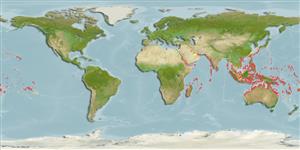>
Eupercaria/misc (Various families in series Eupercaria) >
Scaridae (Parrotfishes) > Scarinae
Etymology: Scarus: Greek, skaros = a fish described by anciente writers as a parrot fish; 1601 (Ref. 45335).
More on author: Forsskål.
Environment: milieu / climate zone / depth range / distribution range
Ecologia
marinhas associadas(os) a recifes; intervalo de profundidade 2 - 25 m (Ref. 58302). Tropical; 36°N - 35°S, 30°E - 123°W
Indo-Pacific: Red Sea south to Sodwana Bay, South Africa (Ref. 5490) and east to the Hawaiian, Marquesan, and Tuamoto islands, north to southern Japan, south to Shark Bay, Western Australia and Lord Howe Island.
Length at first maturity / Tamanho / Peso / Idade
Maturity: Lm 12.6, range 11 - 14.8 cm
Max length : 43.0 cm TL macho/indeterminado; (Ref. 125599); peso máx. Publicado: 1.8 kg (Ref. 125599); Idade máx. registada: 5 anos (Ref. 13619)
Espinhos dorsais (total) : 9; Raios dorsais moles (total) : 10; Espinhos anais: 3; Raios anais moles: 9. This species is distinguished by the following characters: median predorsal scales 4; 2 scale rows on cheek, 1(5-7), 2(4-7); pectoral-fin rays 13-15 (usually 14); female usually 1 conical tooth on side of upper dental plate, terminal male with single tooth on side of lower dental plate, lips largely covering dental plates; caudal fin slightly emarginate in small female to deeply emarginate in large TP male. Colour of male green to pale brownish with salmon pink or bluish scale margins, a lavender-grey snout, bluish to lavender caudal fin and the nuptial male with a brilliant yellow body; female overall reddish brown to grey, usually pale snout (Ref. 90102).
Inhabit reef flats and lagoon and seaward reefs to at least 25 m depth (Ref. 1602). Found over corals (Ref. 5213, 58652). Benthopelagic (Ref. 58302). Initial-phase fish stage usually form small feeding schools (Ref. 2334). Graze on benthic algae (Ref. 3488). Secrete a mucus cocoon (Ref. 1602).
Life cycle and mating behavior
Maturidade | Reprodução | Desova | Ovos | Fecundidade | Larvas
Oviparous, distinct pairing during breeding (Ref. 205).
Randall, J.E., G.R. Allen and R.C. Steene, 1990. Fishes of the Great Barrier Reef and Coral Sea. University of Hawaii Press, Honolulu, Hawaii. 506 p. (Ref. 2334)
Categoria na Lista Vermelha da IUCN (Ref. 130435: Version 2024-1)
Ameaça para o homem
Reports of ciguatera poisoning (Ref. 130160)
Utilização humana
Pescarias: espécies comerciais; Aquário: Espécies comerciais
Ferramentas
Relatórios especiais
Descarregue XML
Fontes da internet
Estimates based on models
Preferred temperature (Ref.
123201): 24.7 - 29, mean 28.1 °C (based on 2928 cells).
Phylogenetic diversity index (Ref.
82804): PD
50 = 0.5000 [Uniqueness, from 0.5 = low to 2.0 = high].
Bayesian length-weight: a=0.01549 (0.01287 - 0.01864), b=3.04 (3.00 - 3.08), in cm total length, based on LWR estimates for this species (Ref.
93245).
Nível Trófico (Ref.
69278): 2.0 ±0.00 se; based on food items.
Resiliência (Ref.
120179): Elevada, tempo mínimo de duplicação da população menor que 15 meses (K=0.35; tmax=5).
Fishing Vulnerability (Ref.
59153): Low to moderate vulnerability (25 of 100).
Nutrients (Ref.
124155): Calcium = 62.3 [39.0, 112.6] mg/100g; Iron = 1.12 [0.74, 1.78] mg/100g; Protein = 18.7 [16.6, 20.5] %; Omega3 = 0.0906 [, ] g/100g; Selenium = 25.9 [15.1, 44.1] μg/100g; VitaminA = 25.9 [7.2, 99.1] μg/100g; Zinc = 2.66 [1.95, 3.62] mg/100g (wet weight); based on
nutrient studies.
